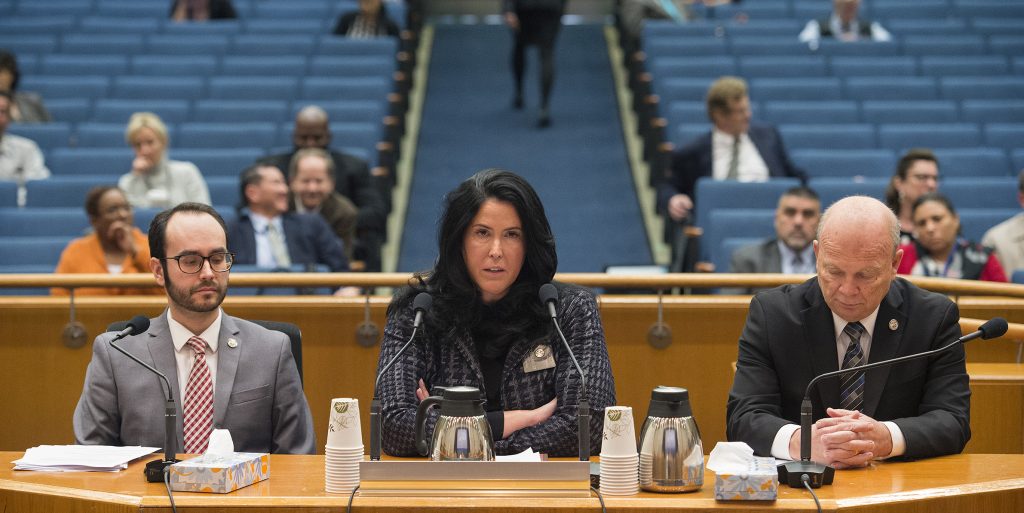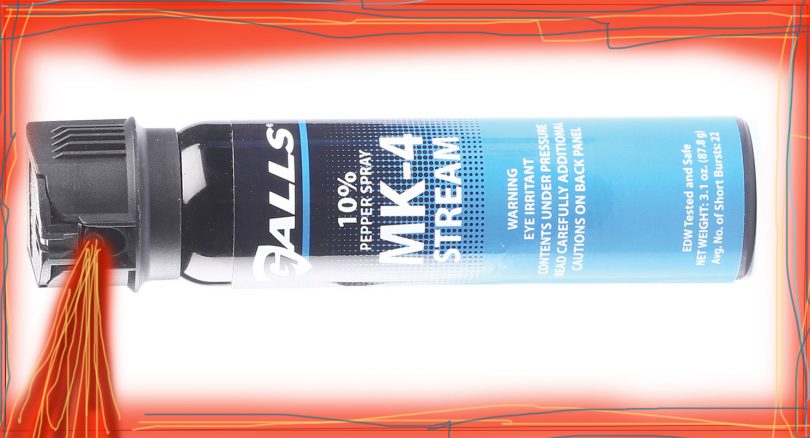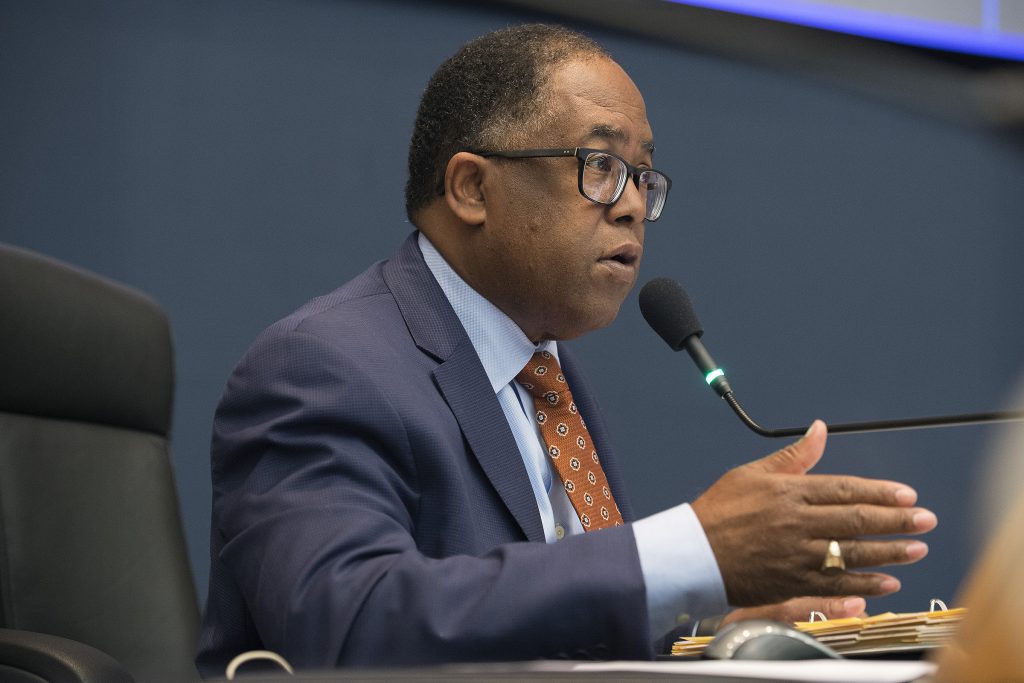In a 28-page report presented to the Los Angeles County Supervisors on Tuesday, February 5, the Office of the Inspector General paints a distressing picture of the use of pepper spray on the kids in the county’s care who are housed in its three juvenile halls and two of its youth probation camps.
And while the OIG’s report, presented by Assistant Inspector General Cathleen Beltz, doesn’t out-and-out say whether or not LA County should join the 35 states in the union that have banned the use of aerosolized Oleoresin Capsicum, commonly called OC-spray or pepper spray, in youth facilities, the report tiptoes right up to the edge of such a directive.
(California is one of six states—in addition to Illinois, Texas, South Carolina, Indiana and Minnesota—that allow staff in juvenile facilities to carry OC canisters.)

OIG Team, Cathleen Beltz, Asst. Inspector General, at center. Photo by Diandra Jay/Board of Supervisors
As Assistant IG Beltz pointed out, before the report outlines its 18 recommendations, it firmly and unequivocally advises the county to “evaluate whether the use of OC spray” in its facilities, aligns with probation’s “philosophical shift toward rehabilitation and trauma-informed care and its ongoing implementation of the LA Model.”
Furthermore, most the information in the body of the OIG report demonstrates fairly convincingly that, if the nation’s largest juvenile probation system really wants to claim rehabilitation and healing as its guiding approach to the kids who come through its doors, that mission doesn’t easily dovetail with the use of OC spray on those same kids.
Lots and lots of spraying
The OIG’s report came about in response to a motion authored by Supervisor Mark Ridley-Thomas, and co-sponsored Supervisor Janice Hahn, which was passed on December 18, of last year, and pointed to “safety concerns” in the county’s juvenile halls and youth probation camps.
The motion was prompted in part by the discovery in March 2018, that the use of pepper spray in the County’s three juvenile halls had risen at a disturbing rate between 2015 and 2017, a fact that was perplexing since the youth population in probation’s youth facilities was continuing to fall.
In Los Padrinos Juvenile Hall, use went up 214 percent. In Barry J. Nidorf Juvenile Hall in Sylmar, use rose 192 percent. And at Central Juvenile Hall, pepper spray use shot up 338 percent.
In December 2018, probation reported that pepper spraying had dropped some over 2017. But it was still high, and there were concerning reports of its overuse and misuse.
The motion instructed IG Max Huntsman and his office to investigate these escalating concerns about use of force, with a special focus on the “use of force including pepper spray.”
After all, it was twelve years past the truly bad old days when, on November 6, 2006, the US Department of Justice began investigating LA’s juvenile probation camps, and found the facilities rife with horrors. Probation officers batted kids around, instigated fights, randomly denied bathroom breaks, recreational time, and/or medical treatment, failed to check on kids who were on suicide watch, drank alcohol on the job, and pepper sprayed teenagers with abandon.
At that time, probation managed to dodge a federal consent decree only by agreeing to 41 demands for reform spelled out in a 2008 Memorandum of Understanding with the government.
It took until mid-2015 before DOJ monitors finally pronounced LA probation to be “in compliance” with what had grown into 73 reforms demanded by the Civil Rights Division of the US Department of Justice.
But now, three years after the DOJ packed up and went home, officers had been doubling or tripling their use of pepper spray in five of the county’s juvenile facilities?
What was going on?
Appropriate intervention or abuse?
In the course of its research for Tuesday’s report, OIG staff spoke with more 45 kids in the county’s three juvenile halls, and at Camp Ellison Onizuka, and Camp Ronald McNair, which are the only camps where OC spraying is allowed.
In addition, they spoke with more than 30 line staff and supervisors, plus probation leadership.
According to the report, most of the probation officers the OIG staff interviewed “expressed a passion for their work and a determination to positively affect the lives of youth.”
Yet, when it came to the use of OC Spray, the investigators found that too often it was used, not as the “final and ultimate authorized” method to “gain control of a situation and/or subdue” youth as is dictated by probation policy—but as the “first or second resort.”
Failure to decontaminate
In several incidents, wrote the OIG, the use-of-force reports filed by probation staff described kids behaving in ways that were “aggressive or threatening,” even when available video footage showed that the kid or kids appeared to “pose no threat to staff.”
Worse, according to kids interviewed by investigators about incidents in which they were OC sprayed, or others around them were, in an unsettling number of cases, said the kids, the staff didn’t allow them to properly “decontaminate,” in other words to get the skin-burning substance off their bodies quickly and well.
“Staff appear to repeatedly place recently sprayed, un-decontaminated youth in their rooms,” wrote the report’s authors. “In several incidents, youth appear to have been left in their rooms, visibly struggling, for periods exceeding fifteen to thirty minutes, without apparent efforts to decontaminate them.”
In still other instances, kids were exposed to OC spray, then placed in rooms with toilet and sink units, but where the sink water was either not functioning or was turned off. In videos the inspectors view, “youth can be seen attempting to self-decontaminate from the toilet.”
In one incident the OIG reviewed, a boy “with a mental health condition” was engaging in self-harming behavior, and was OC sprayed in the groin and buttocks.
Following this use of OC spray, the frantic boy was one of those who was left in a room, which apparently lacked running water, for approximately 20 minutes before being decontaminated.
Another boy reported to investigators that he’d heard others suffering in their rooms “on several occasions following the application of OC spray.”
Several kids described staff-led decontamination efforts that involved either hot water or just wet towels with which to scrub themselves, “two improper decontamination practices” that increase the effects of the OC spray, not lessen them.
And there were other problems. The report found that certain staff use OC spray as a threat, wordlessly shaking OC canisters at kids without first giving verbal commands.
In other instances, youth described being given non-specific commands that didn’t allow them to comply before being sprayed.
“While threatening the use of OC spray may achieve compliance in some situations, it appears to have unnecessarily escalated confrontations in others,” wrote the OIG authors.
Training, Training, Training
When it came to the interviews with those who work in the halls and the two camps, the OIG reported officers “frequently expressed fear regarding their personal safety,” with several citing “inconsistent and inadequate staffing” as a chief source of unease.
Another important topic mentioned by staff was training.
“In particular,” according to the report, staff talked of “a lack of training in de-escalation and physical intervention techniques.”
The OIG authors noted that staff viewed de-escalation and physical intervention techniques to be “perishable skills” that require “regular and frequent training to master.”
As a consequence, around one-third of the report’s 18 recommendations pertain to training.
Apart from training, there was another strong theme that emerged.
The force of mutual respect
According to the report, both the kids and the staff interviewed “consistently spoke with one voice on a particular topic.”
That topic was the importance of relationships, interpersonal communication, and mutual respect as the most crucial ingredient in improving safety and preventing force.
“Several staff reported never having to rely on physical intervention or OC spray when dealing with youth,” wrote the OIG authors.
Instead, those officers told the investigators that their use of “verbal judo” or their “gift of gab” were the skills and attributes that allowed them to address problem behaviors, and “minimize the need to rely on force.”
These same officers told investigators that they felt the department’s training did not provide them with these kinds of effective use-of-force alternatives.
The kids interviewed similarly praised certain staff whom they said were “respectful,” and willing to get to know them as individuals. These officers, the kids said, would “go to great lengths to build rapport with them, rather than using OC spray and/or force in interacting with them.”
On the other side of the relational coin, kids told investigators about officers who would deny them access to certain programs, including religious services. Such staff, said kids, “believed they did not deserve such a privilege.”
At Tuesday’s meeting, several young people who’d been through the pepper spray experience as teenagers in LA’s juvenile halls and camps described similar feelings.
“It’s dehumanizing,” said 25-year-old Kent Mendoza of being sprayed at an LA County camp as an adolescent. On top of the pain, he said,, the experience is re-traumatizing to already traumatized youth. “Every time you pepper spray a 15-year-old kid, you’re telling him, ‘You belong here, and we’re preparing you for prison.'”
“Abuse of children”
Probation Chief Terri McDonald, who spoke at the meeting and praised the OIG’s work, also put out a written statement in response to the report, which noted that probation “recently re-evaluated over 600 use of force incidents,” focusing primarily on uses of OC spray.
It was during the review of those incidents, she said, that probation found “several alarming cases of what appear to be unnecessary or excessive force that had not been previously reported.”
As for continuing the use of OC spray, the chief said that she is “committed to giving the staff the tools they need,” but wants to “eventually eliminate the need for use of OC in juvenile detention.”
When Los Angeles County Public Defender Ricardo Garcia spoke to the board, he went still further.
“In no uncertain terms, it is abuse of these children,” he said of the painful accounts of OC Spray use in the report. Garcia, whose attorneys represent hundreds of youth in the county’s juvenile halls, the majority of whom, he pointed out, are being held pre-adjudication.
What was most telling to him in the OIG’s investigation, Garcia said, was the report’s description of some of the county’s probation officers who said they resolve problems by “building rapport.” And how the kids interviewed for the report said, in turn, that they “felt respected,” by such officers.
We know, Garcia said, that those officers said ‘We never use pepper spray. We don’t feel we have to use violence.’…And so when they go to work every single day, they use other methods to do their work. And they’re successful at it.”
Union boss says nothing else works, and compares non-violent de-escalation of teenagers with roping calves.
At the other end of the philosophical spectrum, Jim Schoengarth, the president of the Association of Probation Supervisors, SEIU 721, and BU 702, did not agree at all that OC Spray should be eliminated.
Chief McDonald, he said, was “currently replacing” the department’s Safe Crisis Management policy “with Non-Violent Crisis Intervention,” which was not a program “that will work with our population.”
To do what probation asks, he said, was akin to “a rodeo where the cowboy takes down the calf.”
“Pepper spray appropriately applied and triaged is safer.”
Next Steps
A few days before the release of the OIG report, a group of prominent justice advocacy organizations including the Youth Justice Coalition, the Southern California ACLU, the Children’s Defense Fund, The Urban Peace Institute, and the Anti-recidivism Coalition (or ARC), sent their own report to the LA County Supes, pushing for the board to ban the use of pepper spray on kids altogether.
Youth who have been subjected to OC spray in Los Angeles consistently describe it as traumatic, the coalition’s report pointed out. “[Y]ou feel like your body is on fire,” said one youth. Youth have described witnessing others have serious allergic reactions, including breaking out with “welts all over their face”
Finally, before the topic was closed for the day, Supervisor Mark Ridley-Thomas read in a motion, the first part of which was voted on and passed on Tuesday.
It instructed the Probation Reform and Implementation Team (PRIT), to “hold a special hearing (Hearing) on this report and safety concerns in Los Angeles County’s juvenile justice facilities, and report back to the Board of Supervisors with any recommendations.”
(PRIT is the group that is meeting regularly and very publicly in order to shape the soon-to-be-created LA County Probation Oversight Commission.)
“It’s high time we come to grips with this – no more excuses,” Supervisor Ridley-Thomas said of the report.
“Several findings of the investigation point to a punitive culture lacking in accountability,” he said. “Our responsibility is to protect the basic human rights of the youth in our care – not further traumatize them.”
And so the story continues.





The Board of Supervisors loves to create political entities like the office of the inspector general because it makes the BOS look like it’s doing “something” and gives political cover when the inevitable scandal pops up. The problem with creating phoney baloney entities (like the OIS) is that they tend to find phoney problems in order to justify their phoney jobs. This is a pretty good example.
When dealing with the most violent “kids” in LA county, pepper spray seems like a pretty reasonable method. Btw I think it’s pretty hilarious the OIS has “discovered” that some probation officers are better at the job than others, amazing.
Violent kids? Have you checked the data about who exactly we are locking up in juvenile halls and probation camps? The recent data from the OIG elucidated the fact that 85% of the kids incarcerated are there for non-violent offenses, including kids who missed their probation appointments. Pepper spray is a symptom that the entire juvenile justice system in LA County is broken. What did people expect to happen when they designed these facilities to warehouse kids? The design is all wrong! And it is bad for staff and kids!
Obviously those who advocate/propose the ban of using pepper spray in juvenile halls have no idea how physical and violent these outbursts and confrontations can be, whether in a juvenile custody environment or in the home of an out-of-control, violent teenager. Having worked patrol as a deputy, sergeant, and lieutenant on the Sheriff’s Department, I can attest to this.
Pepper spray has been proven time and time again to be the most effective method to quell situations ranging from passive-agressive non-compliance incidents, to a simple assaults, or to stop even a physical assault that is about to escalate into a situation that can even justify the use of less-lethal, or deadly force.
I am sure the Sheriff’s Departments and police departments across the country can provide endless videos of actual incidents that will prove my points to be true and correct.
Part of the L.A. County Sheriff’s Department’s academy training back then (not sure about now since I’m retired) included the recruits being directly exposed to OC spray and tear gas. All it takes is a rinse of cool water for several minutes and the effects, burning sensation will dissipate.
The people who are proposing the ban should go through some sort of abbreviated “use-of-force” training, to familiarize themselves with the use-of-force options that are available to law enforcement patrol and custody personnel, before jumping the gun (no pun intended), and enact policies that WILL eventually cause the loss of limbs, or GOD forbid, a life because the option of using OC is taken away from the people who are responsible for the safety and care of those in custody as well as members of the public.
In adult custodial facilities such as in L.A. County jails, deputies suffer broken, fractured hands when they have to resort to using physical force to subdue a violent inmate. I had several deputies fracture or break their hands/fingers while I was a custody watch commander. In some of these situations, the use of pepper spray would have resulted with the same desired effects, i.e., subdue/gain compliance. A fractured or broken hand results in costing thousands of dollars of taxpayers’ money. Bone injuries usually take up to 8 to 10 weeks to heal, during which time the injured employee is at home on disability and his/her position is backfilled with overtime, then are are other related the medical costs, rehabilitation, and long-term follow-ups. These are the personnel costs and don’t even address of the injury/injuries sustained by the offending party (the juvenile or adult in custody).
Taking away pepper spray means the custody personnel will have to be totally hands-on and use physical force to subdue, restrain, increasing the possibility of the confrontation to escalate to more violence. When the use of the hands and the feet don’t work, then the “weapons of necessity” will have to be applied, broom sticks, chairs, tables, staplers, t.v.’s, or anything within reach.
And so, please consider my suggestions:
1) Ask your law enforcement contact to give you an overview of the use-of-force training, which incorporates some application and exposure to O.C. spray.
2) Review video footage of real-life situations where pepper spray had resolved a violent situation, especially where the use of deadly force would also have been justified.
3) Request the Sheriff’s Department to let you view videos of jail riots where the use of the pepper spray guns have worked, and worked very well.
4) Tour the juvenile halls and see for yourself how big some of these kids are and how physically powerful they can be, and ask yourself if you would want to be locked in a room with 2 or 3 or more with them? Also ask for the ratio of officer to juveniles. Look around the room and assess what the choices of “weapons of necessity” and imagine the end result of the injuries to either the officer or the juveniles.
5) Account for the number of law suits against the county regarding the use of pepper spray, versus law suits involving other uses of force. The numbers will speak for themselves.
That’s all I can think of right now. I hope my input helps.
Respectfully,
Retired L.A. County Sheriff’s Lieutenant
It is perplexing, deeply troubling, alarming, unconscionable, and deeply concerning, that liberal justice warriors, don’t understand these kids could be violent. It would be less deeply concerning, and less alarming, and considerably less deeply troubling if the liberal social justice warrior would volunteer their time to counsel and guard these poor deeply troubled kids.
Hey mike ,if juvenile halls and probation camps are full of nonviolent kids, where do they lock up the violent criminal-kids? I’m for whoever is guarding those kids to get pepper spray (and whatever else they need). On the other hand why don’t we just let the people who are in charge of that stuff decide what they need.
Kids with 707b offenses are locked up in the compound or sent to a Department of Juvenile Justice facility (two in Stockton and one in Stockton). Any more questions?
Lastly are you sure want to let those in charge make decisions? Remind me again how long they were on federal oversight? Remind me again how much money we taxpayers have dished out for sexual assault cases because of bad probation officers? Let’s just say that I am over the fact that we are spending close to $300,000 of my tax dollars to incarcerate a kid who may have stolen a stereo or a car or got caught with weed or alcohol. I don’t condone the behavior but let’s get serious in the fact that we jam-packed as many kids as we could into every facility we had because these were good paying public sector jobs. I mean who wouldn’t love the 56-hour work shift in the camps. I’d get two jobs given that amazing work schedule. No wonder i see a ton of BMWs, Mercedes Benz and expensive cars in the parking lot at Probation headquarters. Enough is enough!
Examples from the Sheriff’s Department? Hilarious. Next.
You have less kids in custody than anytime in the history of the Probation Department. And you have the same number of staff since no one has lost their job. And your budget has increased from $200 million 10 years ago to $500 million in FY 2019-20. So again you have the right staffing ratio. You have the money. And last but not least, 35 states have banned pepper spray; yet you have not heard a peep from any of them that they made a mistake. Let me guess our kids are different than kids in other states?
Are you saying all of la county’s violent kid offenders are locked up in Stockton? I’m pretty sure most reading this don’t know what a 707b offense is (myself included,) or for that matter what you mean by “the compound”. Your first statement seems purposefully confusing like you’re dodging the question. It appears you have a bit of an ax to grind with the probation dept, that’s ok but why don’t you tell us about so we can judge your obvious bias.
Mike Stevenson:
“Lastly are you sure want to let those in charge make decisions?”
Then, in God’s name, tell us who YOU would want to make those decisions.
Out with it!!!
Poor Mike is EXACTLY the kind of advocate who should be put in a uniform and allowed to run boards for a month in any LA County Hall or camp. Then, after being gassed, kicked in the stomach, bashed in the face with a telephone or hit in the face with a chair he can think over oleoresin capsicum’s value. Join in a major disturbance with 16 minors where seconds count during a four-on-one beat down and see what a single arm assist is worth. After you come back from your industrial accident leave in a few months from trying, with five other officers, to contain a 6’3″ child weighing 275 lbs., you’ll be writing a different letter to WLA.
It’s always easy to “critique, monitor, Monday morning quarterback, criticize, review and second guess” the actions taken by others during a stressfull, dynamic and evolving event after the fact in the comfort of a “safe and stress-less environment”.
I guess the goal should be to have a role of risk-free “critiquer” versus a that of the risk-filled “hands on doer”? It is amazing how the courts had at one time recognized the fact that the actions of law enforcement in these instances “would be different than folks under ideal and normal conditions” and the application of a “reasonableness” standard was used a yardstick by which to measure/guage the appropriateness of their actions.
It is amazing how with the support of a political administration, biased media campaign, social justice warriors, opportunistic politicians and activist judges, public sentiment has been swayed/manipulated, while case law and policies relating to law enforcement have been up-ended across the board based on a few isolated incidents.
The “puplic trust” for the enforcement end of the legal system has been “erroded, broken down and decimated” for the entire group based on isolated incidents with the gleefull support of politicians, shady lawyers and biased judges.
Members of the US Congress saying abolish ICE? Really? Sanctuary laws that tie the hands of local law enforcement and order them to cherry pick and selectively enforce only those laws the local legislatures agree with. WOW!
Laws to limit and re-define the criteria under which law enforcement can use deadly force?
It is dangerous for “ploitical leaders” in our society to supports a socialistic “anti-authority”, disrespect narrative for the masses, especially by the example it has set for a generation of young people.
Many Law Enforcement Leaders in this state of California are in favor of Sanctuary Laws, so what’s your view on that.
Correct me if I’m wrong but I believe that the new Sheriff and Police Chief of Los Angeles County and City are favor of sanctuary laws.
….many are not, ask those in Northern California where the two officers were killed last year and the beginning of this one.
Mr. Stevenson, you are incorrect. You dismissively note that 707B offenders go the state or are in the compound. For some, that’s true but in some cases, the DA can’t prove the 707B charge and they file a lesser charge right out of the gate. Others charged with a 707B offense are adjudicated for a lesser offense and these youth are in camps and halls. If people ever read the files of some of these youth, they’d be shocked.
Further, many are detained for violent crimes that are not 707B offenses. Independent of the charges that might have caused them to be detained, multiple youth in camps have been removed for court proceedings in a new matter, involving allegations of murder or other serious charges.
Last, the number of kids in halls and camps has significantly declined over the last few years as lightweight offenders are not being accepted at the juvenile halls based upon research that indicates that they are damaged by associating with those more criminally sophisticated. Certainly there are the occasional “contempt of judge” remands but those are the exception and not the rule.
I am not for a moment saying that all people don’t need to be treated appropriately regardless of offense but the idea that the Probation Department is housing those busted for shoplifting and curfew violations is absolutely wrong. The bottom line is the Department houses a significant number of youth that are well used to using violence to solve problems and have no problem attacking each other or staff. The proper use of pepper spray keeps youth and staff safer than they will be without it.
From the LATimes today… OC spray wins again..
BTW, I graduated from Pomona High School back in the early 80s.. we had riots frequently in my senior year. Kids ran through campus with sticks, bats, breaking windows, etc. Riot bell would ring and teachers rushed to lock us inside the classrooms. One teacher’s car had a bat driven through the roof of her car. You don’t think teenagers are violent? Think again. Unfortunately, some of these kids in JV hall are prison bound when the become adults. Being in JV hall is a rite of passage and feather in the cap to them. You want to fix it? Start fixing it in the home.
….
Riot erupts at Donovan state prison, injuring 10
Pepper spray is used to break up fights involving nearly 50 inmates in Otay Mesa.
THE MELEE began in a yard at the Donovan Correctional Facility. (Howard Lipin S.D. Union-Tribune)
By Teri Figueroa
SAN DIEGO — Ten inmates were injured — at least one seriously — when nearly 50 inmates rioted Friday morning at a state prison in Otay Mesa, officials said.
Shortly before 9 a.m., several fights broke out in the Facility A yard at Robert J. Donovan Correctional Facility, California Department of Corrections and Rehabilitation officials said in a news release.
The facility houses inmates classified as medium-security risks, and they were in the outdoor yard for their morning recreation.
Corrections officers quelled the riot with pepper spray after inmates ignored multiple requests to stop fighting, the department said.
No lethal force was used to break up the melee, which took about three minutes to halt, prison Capt. Philip Bracamonte said.
Ten inmates were taken to hospitals. One suffered serious head injuries and was flown to a hospital by helicopter, the department said.
Three of the inmates sustained “major trauma,” and the rest had “minor trauma,” Patrick Walker, battalion chief with the California Department of Forestry and Fire Protection, told OnScene TV.
None of the correctional officers were hurt.
Staffers exposed to pepper spray were treated at the prison.
Prison officials said multiple “inmate-manufactured weapons” — commonly known as shanks — had been found at the scene.
Facility A houses about 640 inmates, Bracamonte said, but he was not able to say how many were in the rec yard when the trouble started.
The captain said the investigation will include inmate interviews “to determine if there was any tension on the facility and what may have led up to this riot.”
The riot marks the second time the prison has been in the news this week.
According to a federal complaint unsealed Wednesday, a prison employee has been arrested on suspicion of smuggling cellphones into the facility in exchange for about $13,000 in bribes.
In December, two inmates were stabbed when about two dozen inmates rioted in a maximum-security yard.
The 32-year-old prison houses about 3,800 — who are classified at security levels of minimum, medium and maximum — and employs 1,850 people.
Figueroa writes for the San Diego Union-Tribune.